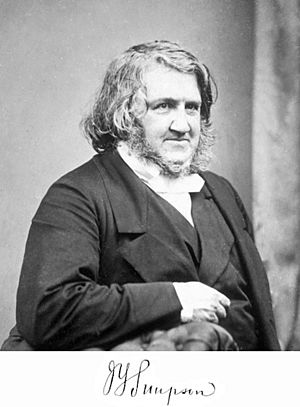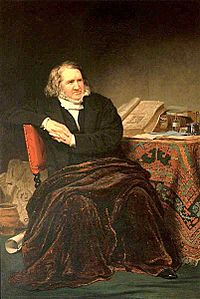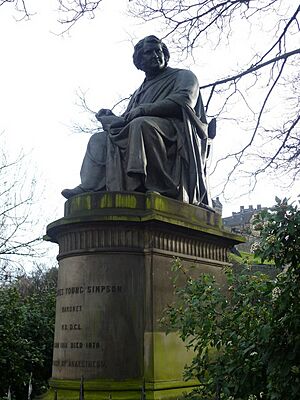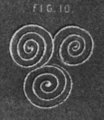James Young Simpson facts for kids
Quick facts for kids
James Young Simpson
|
|
|---|---|

James Simpson
|
|
| Born | 7 June 1811 Bathgate, West Lothian, Scotland
|
| Died | 6 May 1870 (aged 58) Edinburgh, Scotland
|
| Alma mater | University of Edinburgh |
| Known for | Use of chloroform as anaesthetic in childbirth, design of obstetric forceps |
| Spouse(s) | Janet Grindlay (m. 1839) |
| Children | 1. Margaret Grindlay Simpson
2. Sir Walter Grindlay Simpson, 2nd Baronet And 7 others |
| Notes | |
|
James Young Simpson (great nephew)
|
|
Sir James Young Simpson, 1st Baronet (7 June 1811 – 6 May 1870) was a very important Scottish doctor. He is famous for being the first doctor to show that chloroform could be used to make people unconscious during medical procedures. He also helped make chloroform popular in medicine.
Simpson was interested in many things, from old history (archaeology) to helping women with their health. He believed that midwives should work in hospitals. Many important women asked him for help with their health issues. He also wrote books about his medical ideas.
Because of his work in women's health and improving hospitals, he was made a knight. By 1847, he was even appointed as the Queen's doctor in Scotland.
Simpson was a good friend of Sir David Brewster. His work with chloroform changed surgery a lot.
Contents
Becoming a Doctor
James Simpson was born in Bathgate, Scotland. His father, David Simpson, was a baker. In 1825, when he was 14, James started studying at the University of Edinburgh. Two years later, he began his medical studies.
He earned his medical degree in 1832. While at university, he took extra classes from famous surgeons like Robert Liston. His excellent thesis on inflammation led Professor John Thomson to hire him as an assistant.
As a student, he was a leader in the Royal Medical Society. This started his lifelong interest in helping the society grow. His first job was as a family doctor in Edinburgh. At just 28 years old, he became a professor of medicine and midwifery at the University of Edinburgh.
Amazing Medical Discoveries
Simpson's biggest achievement was bringing anaesthesia (medicine to make you sleep during surgery) to childbirth. He also made better designs for obstetric forceps, which are tools used to help deliver babies. These tools are still sometimes called "Simpson's Forceps" today.
In 1838, he designed the Air Tractor. This was an early type of vacuum extractor. It helped with childbirth, but this method didn't become popular until much later.
Simpson was a religious person and a member of the Free Church of Scotland. However, he didn't agree with everything in the church's beliefs, especially about the book of Genesis.
Simpson lived in a large house called Strathavon Lodge. He also had a town house in Edinburgh and a country house near Bathgate.
Chloroform and Childbirth
The first anaesthetic, nitrous oxide (laughing gas), was used in 1799 by Sir Humphry Davy. In 1846, William T. G. Morton showed how ether could be used as an anaesthetic. But ether often irritated patients' lungs.
Chloroform was invented in 1831, but no one had really explored its uses. In 1842, Dr. Robert Mortimer Glover described how chloroform affected animals. He even won a medal for his research, but he didn't think it was safe enough for humans.
In 1847, Simpson discovered chloroform's effects on humans. He was experimenting with friends in his dining room, trying different chemicals to see if they could make people sleep. After getting a sample of chloroform, Simpson and his friends decided to try it themselves on November 4, 1847.
They inhaled the chemical and felt cheerful, but then they all collapsed! They woke up the next morning. Simpson immediately knew he had found a new anaesthetic. Soon after, his niece, Miss Petrie, tried it. She fell asleep while singing, "I am an angel!"
There's a popular story that the first baby born using chloroform was named "Anaesthesia." But the baby's real name was Wilhelmina. "Anaesthesia" was just a nickname Simpson gave her.
It was very lucky that Simpson survived his experiment with chloroform. If he had inhaled too much, it could have been very dangerous. But his willingness to explore new possibilities made him a pioneer in medicine. His discovery led to chloroform being used in childbirth and for soldiers. The British Medical Journal said his work changed medicine for a century.
Studying Old Things
Simpson joined the Society of Antiquaries of Scotland in 1849. He became its vice-president in 1860. He wrote about the history of medicine and also about archaeology (the study of old human history).
He wrote an important book about ancient rock carvings called Archaic Sculpturings of Cups, Circles, &c. Upon Stones and Rocks in Scotland, England, & Other Countries. In this book, Simpson listed and described many examples of these carvings from different places. After he died, his writings about old things were published in two books.
Family Life
In 1839, Simpson married Janet Grindlay. Her father, Walter Grindlay, was a wealthy shipping owner in Edinburgh and Liverpool. James and Janet were cousins.
Simpson sometimes relied on Walter Grindlay and his family for financial help during his career.
Death and Tributes
Simpson was chosen as the President of the Royal College of Surgeons of Edinburgh in 1850. In 1866, he was made a Baronet, which is a special honor. He passed away at his home in Edinburgh in May 1870, at 58 years old.
His family was offered a burial spot in Westminster Abbey in London, a very famous church. But they chose to bury him closer to home in Warriston Cemetery, Edinburgh. However, there is a memorial statue of Simpson in Westminster Abbey.
On the day of Simpson's funeral, Scotland declared a holiday. Banks and stock markets closed. Over 100,000 people lined the streets for his funeral procession. More than 1,700 doctors and business leaders took part in the procession.
His nephew, Dr Alexander Russell Simpson, inherited his town house at 52 Queen Street in Edinburgh. There is a plaque on the wall outside the house to show that James Young Simpson lived there from 1845 to 1870.
Several hospitals and buildings have been named in his honor. These include the Edinburgh Royal Maternity and Simpson Memorial Hospital (1879) and the Simpson Memorial Maternity Pavilion (1939). Today, the Simpson Centre for Reproductive Health at the Royal Infirmary of Edinburgh is also named after him. A main street in Edinburgh, Simpson Loan, is also named in his honor.
Images for kids
See also
 In Spanish: James Young Simpson para niños
In Spanish: James Young Simpson para niños
- Charles Thomas Jackson, who also claimed to have pioneered the use of diethyl ether.
- Crawford Williamson Long, who discovered the anaesthetic effect of diethyl ether.
- William Thomas Green Morton, who pioneered the use of diethyl ether in surgery.
- Humphry Davy, who first suggested using nitrous oxide in 1799.
- Horace Wells, who pioneered the use of nitrous oxide in the US in 1844.







